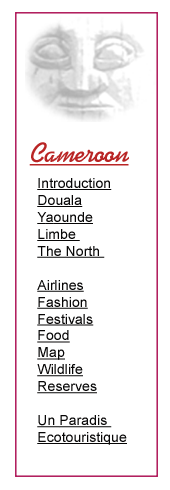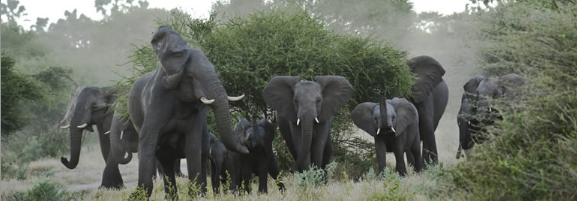
|
|
|
Mt. CAMEROON DESIGNATED AS NATIONAL PARK
By Peter Ngea A new park created by the Cameroonian government that encompasses the highest mountain in West and Central Africa will help protect some of the rarest ecosystems in the Congo Basin. The Government of Cameroon recently signed a decree creating the 58,178 hectare Mount Cameroon National Park, which includes the 4,095-metre high Mount Cameroon - also one of the largest active volcanoes on the African continent.
"A park of such importance will help animal populations to
rebuild," said Atanga Ekobo, Manager of the world Wildlife Fund
(WWF) Coastal Forest Project, which covers the region. "I will
also encourage the sustainable use of natural resources by
introducing and promoting alternative sources of income to the
local communities>"
Mount Cameroon is an important refuge and home to many species
found nowhere else, including high numbers of plants.
A very isolated population of forest
elephant also lives there.
African Wildlife Foundation will provide technical assistance. At 3,300 sqare kilometers, Faro National Park is one of the largest parks in Cameroon and is home to significant numbers of elephant, Cameroon’s largest population of hippopotamus as well as Lord Derby eland, roan antelope, giraffe, lion, leopard, and cheetah. To protect these species, AWF will strengthen existing counter-poaching forces, providing much-needed training and equipment. AWF will also help village and park guards integrate new ecological-monitoring procedures and technology into their patrols. North Carolina and Cameroon Organizations Partner to Protect Elephants
Dr. Mike Loomis from the North Carolina Zoological Park traveled to Africa and join his colleagues from the World Wildlife Fund-Cameroon and the Cameroon Ministry of Environment and Forests. For the eight weeks, the team worked to place satellite collars on as many as three new elephants, and also attempt to recover collars from some of the animals we've monitored over previous years. After arriving in Yaounde, the team l traveled to Boumbabek Nki (which lies just west of the newly-designated Lobeke National Park) and collar one elephant. While in Boumbabek, Dr. Mike also brought website visitors up-to-date on the effort to protect that region as Cameroon's newest national park. From Boumbabek, the team moved on to Waza National Park to collar an animal in Mahamat's herd and to recover Falama's GPS collar and the migration data it contains. The following is from a report prior to Dr. Mike'slast trip to Cameroon in March (update to come) The next destination was Benoue National Park, where the team will collar a member of Eka's herd and try to recover collars from both Eka and Dii. Depending on how long it takes to accomplish these tasks, the team may also collar a giant eland. Finally, if time permits, the team will travel to Kalamaloue to retrieve Saleh's collar. As in previous years, Dr. Mike will be in frequent contact with visitors to "The Elephants of Cameroon" website. We expect to update his field diary on a daily basis, and also to receive photos and video from the field over the next two months. Dr. Mike will also be answering students' questions, suggesting discussion topics, and asking for assistance in naming newly-collared elephants and solving problems that crop up while in the field. We hope that you will be part of this year's field activities. If you have any questions about "The Elephants of Cameroon," please contact Mark MacAllister, Project Coordinator, at mailto:mark.macallister@ncmail.net. Thank you for your interest in Cameroon's elephants and in our efforts to protect them. "The Elephants of Cameroon" (http://www.nczooeletrack.org) Original Story as
appeared in Africa Travel Magazine, December 2001 Perhaps one of Cameroon's greatest natural resources is its diverse wildlife population. An amazing variety of animals&emdash;large and small, plain and spectacular&emdash;wander its savannas and rainforests. However, as Cameroon's human population and commerce expand into previously unsettled territory, the conflicts between animals and humans increase. Unfortunately, that conflict too often ends with the destruction of habitat and the decline of species. Of particular concern to many Cameroonians is the growing competition between people and African elephants. As agriculture expands into historic elephant habitat, for example, incidents of crop destruction, and the subsequent killing of elephants, become more frequent. One way to minimize these conflicts is to better understand how and when specific elephant herds and human populations come into contact. A research team including personnel from the North Carolina Zoological Park (NCZP), Cameroon's Ministry of Environment and Forests (MINEF), and World Wildlife Fund&emdash;Cameroon Programme Office (WWF) is studying elephant migration patterns by placing satellite tracking collars on animals and then analyzing their movements over many months. Dr. Mike Loomis, Chief Veterinarian at NCZP, and Dr. Martin Tchamba of WWF have tracked more than a dozen elephants over the last five years, and have generated a series of homerange maps that detail elephant locations and help predict where herds will be at specific times of year. These maps also highlight travel corridors that the herds use to move between territories. And, by using GIS mapping facilities at the NCZP, they can also understand how such variables as bodies of water, roads, and human settlements influence, and are influenced by, elephant homeranges. This conservation research program also includes an award-winning educational component, The Elephants of Cameroon (http://www.nczooeletrack.org). This website provides students, teachers, parents and others the opportunity to interact with project researchers, and with each other, by posting questions, reading field diaries, exploring elephant location data, and participating in online discussion forums. The site also offers background information about elephants, about the research program itself, and about the nation and people of Cameroon. Since its debut, The Elephants of Cameroon has welcomed visitors from all fifty states in the U.S. and from more than 100 countries around the world. It has also earned numerous awards for instructional effectiveness and website design. By increasing the understanding of elephant behavior, and by increasing opportunities to learn about elephants, the research partnership between NCZP, MINEF, and WWF improves the prospects for the long-term survival of Cameroon's elephants. For more information, please contact Mark MacAllister, NCZP, at mark.macallister@ncmail.net. |
||||

